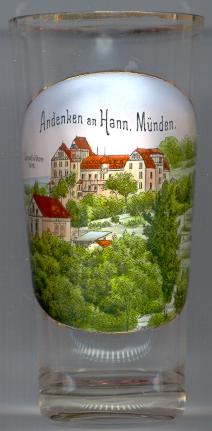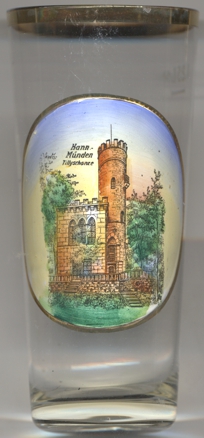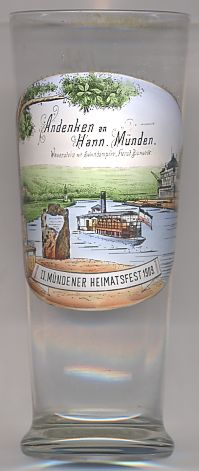

|
| DEUTSCHLAND | GERMANY |
| Bundesland: Niedersachsen | Lower Saxony |
| Landkreis: Göttingen |
Hann. Münden (Hannoversch Münden) is situated at an elevation of 217 m at the confluence of the rivers Fulda and Werra into
the river Weser in southern Lower Saxony. The first mention in a document dates from AD 802 (Gimundi, today Münden's quarter of Altmünden).
The new town was founded about 1175–1175. By 1183, Münden had obtained the formal status of a city. Münden thrived as it had received the
privilege of stockpiling in 1247. This privilege (in effect until 1823) meant that all goods that were to be transported through Münden by foreign
traders had to be put on sale in town first. From 1488 until 1585 Münden was the residence of the Dukes of Calenberg-Göttingen,
a branch line of the House of Braunschweig-Lüneburg of the Welfen family. During the Lower Saxon-Danish
War of 1625–1629, Münden was conquered in 1626 by general Johann t'Serclaes von Tilly (1559–1632) of the Catholic League who killed more
than 2,000 of the 2,800 inhabitants of the town. Between 1776 and 1782 Münden was the place of embarkment for soldiers that were leased to England by
the Landgrave of Hesse-Kassel for the North American War of Independence. In 1819, the first steam ship reached Münden on the
river Weser from Bremen. The railway line from Hannover via Münden to Kassel
(Cassel) (Hannoversche Südbahn) was opened in 1856. Since the administrative reform of 1971 the official spelling of the town's name is
Hann. Münden which had inofficially been used for a long time already, Hann. being the abbreviation of Hannoversch, referring to
the former Kingdom of Hannover. Even the popular pronunciation has become Hann-Münden today. The old town of Hann. Münden, which boasts
more than 700 half-timbered houses dating of a period spanning six centuries, was protected as a cultural monument in 1996.

The picture on the glass shows the former  Lokomotivführer-Heim (Engine drivers' home) [left].
In order to improve health-care for their members, the 'Verein Deutscher Locomotivführer' (Union of German Engine Drivers) founded a recreation and convalescence home for engine drivers who, during their active duty
regularly had to work for some 350–400 hours per month. The house was opened in 1903 and operated until 1981 when it was sold to the city of Münden.
Since then, no new function for the building was found and it was neglected. During the 1990s, a private investors group planned to renovate
the building in order to open an old people's home. However, due to financial problems nothing has happened since then and the building, once listed as an architectural monument, continues to fall into dereliction.
Lokomotivführer-Heim (Engine drivers' home) [left].
In order to improve health-care for their members, the 'Verein Deutscher Locomotivführer' (Union of German Engine Drivers) founded a recreation and convalescence home for engine drivers who, during their active duty
regularly had to work for some 350–400 hours per month. The house was opened in 1903 and operated until 1981 when it was sold to the city of Münden.
Since then, no new function for the building was found and it was neglected. During the 1990s, a private investors group planned to renovate
the building in order to open an old people's home. However, due to financial problems nothing has happened since then and the building, once listed as an architectural monument, continues to fall into dereliction.
Famous people of Münden:
Gustav Heinrich Eberlein (1847–1926) was born in Spiekershausen near Münden. The sculptor, painter and poet is regarded as one of the most important exponents of Historism in Germany. His private collection of paintings, caster plasts and models of his own works, established in the castle of Münden at his own expense, became part of Münden's 'Altertümer- und Eberlein-Museum' in 1898. Most of the plaster figures were deliberately destroyed in 1960 to use the material for new floorings in the castle.
The best-known figure of Münden, however, is certainly Johannes Andreas EISENBART (Eysenbarth; born 1663 in Oberviechtach/Bavaria, died 1727 in Münden). He became one of the best known doctors and surgeons of his time. He specialized in the treatment of cataracts (for which he developed a special needle), polyps, hernias, bladder concrements, harelips and cancers. Because of his reputation, he received special privileges from ten German countries. In order to attract patients as customers, he employed a troop of comedians. This, however, is also the reason why, in later centuries, his name became synonymous for dubious and even cruel medical practices. In order to correct the traditional misconceptions about the merits of Eisenbart, a theatre festival was founded in 1955/58. The play 'Das Spiel vom Doktor Eisenbart', based on the results of historical research, now is one of the centres of the cultural life of Hann. Münden.

The  Tillyschanze ('Tilly sconce') [near left: no. 4358] was built from 1881 to 1885 as a memorial
to the siege of Münden by general Johann t'Serclaes von Tilly in 1626. It is an observation tower in the Reinhardswald above the town. Recent
research shows that Tilly did not set up his cannons at this point, but below the Fulda bank. Since 2010 the tower has been repaired by an association
and by donations.
Tillyschanze ('Tilly sconce') [near left: no. 4358] was built from 1881 to 1885 as a memorial
to the siege of Münden by general Johann t'Serclaes von Tilly in 1626. It is an observation tower in the Reinhardswald above the town. Recent
research shows that Tilly did not set up his cannons at this point, but below the Fulda bank. Since 2010 the tower has been repaired by an association
and by donations.

Glass no. 2233 [near left] is a souvenir from the II. Mündener Heimatsfest 1909 ('2nd Münden Home Festival').
The (old)  Weserstein [foreground left], a boulder ornated with a poem placed at the confluence of the rivers Werra
and Fulda. The monument was placed here on 2 September 1899, the 'Sedantag', a semi-official memorial holiday in the German Empire celebrated to commemorate
the victory in the 1870 Battle of Sedan. In 2000, a new Weserstein was placed a few metres away.
Weserstein [foreground left], a boulder ornated with a poem placed at the confluence of the rivers Werra
and Fulda. The monument was placed here on 2 September 1899, the 'Sedantag', a semi-official memorial holiday in the German Empire celebrated to commemorate
the victory in the 1870 Battle of Sedan. In 2000, a new Weserstein was placed a few metres away.
The ship depicted in the centre background is labeled as  steamship
steamship
Several glasses of this collection show other Bismarck monuments.
Several glasses of this collection show other ships.
[https://de.wikipedia.org/wiki/Hann._M%C3%BCnden;
https://de.wikipedia.org/wiki/Weserstein]
![[scale]](lineal.jpg)